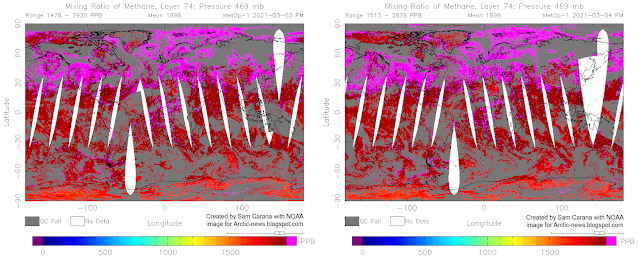Heat is entering the Arctic Ocean from the south, as illustrated by the image on the right. Hot, salty water is entering the Arctic Ocean from the Atlantic Ocean as currents dive underneath the ice, causing the ice to melt from below.
 |
| [ click on images to enlarge ] |
The bottom graph (c) shows a time series from 1985 to 2021 of percent ice coverage of the Arctic Ocean domain. The Arctic Ocean domain is depicted in the inset map with purple shading.
At the end of the ice growth season in mid-March, 73.3% of the Arctic Ocean domain was covered by first-year ice, while 3.5% was covered by ice 4+ years old.
In March 1985, near the beginning of the ice age record, the Arctic Ocean region was comprised of nearly equal amounts of first-year ice (39.3%) and 4+ year-old ice (30.6%).
The image below, by Malcolm Light and based on Max & Lowrie (1993), from a recent post, shows vulnerable Arctic Ocean slope and deep water methane hydrates zones below 300 m depth.
Malcolm Light indicates three areas:
During April 2021, sea ice was about 160 cm thick.
The image below further illustrate the danger. As the temperature of the water keeps rising, more heat will reach sediments at the seafloor of the Arctic Ocean that contain vast amounts of methane, as discussed at this page and in this post.
Ominously, methane levels reached a peak of 2901 ppb at 469 mb on May 13, 2021.
Research
In the extract of a 2008 paper, Natalia Shakhova et al. conclude: ". . we consider release of up to 50 Gt of predicted amount of hydrate storage as highly possible for abrupt release at any time."
The video below contains excerpts from Nick Breeze's interview with Natalia Shakhova at the European Geophysical Union in Vienna, 2012, on the likelihood and timeframe of a large methane release from the seafloor of the Arctic Ocean.
Natalia Shakhova: "The total amount of methane in the atmosphere is about 5Gt. The amount of carbon in the form of methane in this Arctic shelf is - approximately - from hundreds to thousands Gt and, of course, only 1% of [such an] amount is required to double the atmospheric burden of methane."
"But to destabilize 1% of this carbon pool, I think, not much effort is needed, considering the state of the permafrost and the amount of methane involved, because what divides the methane from the atmosphere is a very shallow water column and the weakening permafrost, which is losing its ability to seal, to serve as a seal, and this is, I think, not a matter of thousands of years, it's a matter of decades, at most hundred years."
(Natalia talks with Igor Semiletov)
Natalia Shakhova: "Just because this area is seismically and tectonically active, and there was some investigation that the tectonic activity was increasing, and the seismic activity, the destabiliation of the ground, just mechanical forcing destabiliation [may suffice to act as] additional pathway for this methane to escape. There are many factors that are very convincing for us [to conclude] that it might happen."
Elaborating on the timeframe.
Natalia Shakhova: "Not any time, any time sounds like it might happen today, it might happen tomorrow, the day after tomorrow . . "
Igor Simelitov: "It might!"
The image below was created with content from a 2019 paper by Natalia Shakhova et al. It concludes that methane releases could potentially increase by 3-5 orders of magnitude, considering the sheer amount of methane preserved within the shallow East Siberian Arctic Shelf seabed deposits and the documented thawing rates of subsea permafrost reported recently. 
In a 2021 paper by researchers from Europe, Russia and the U.S., results from field research are published showing that methane is getting released from locations deep below the submarine permafrost. Lead author, Julia Steinbach, from Stockholm University, says: “The permafrost is a closed lid over the seafloor that’s keeping everything in place. And now we have holes in this lid.”
Links
• NOAA Climate at a Glancehttp://ocean.dmi.dk/arctic/meant80n.uk.php
https://www7320.nrlssc.navy.mil/GLBhycomcice1-12/arctic.html
https://cryospherecomputing.tk
• A 4.5 km resolution Arctic Ocean simulation with the global multi-resolution model FESOM 1.4 - by Qiang Wang et al.
• Extinction by 2027- by Malcolm Light
https://www.ospo.noaa.gov/Products/atmosphere/soundings/iasi
https://www.cosis.net/abstracts/EGU2008/01526/EGU2008-A-01526.pdf
https://www.mdpi.com/2076-3263/9/6/251
• Source apportionment of methane escaping the subsea permafrost system in the outer Eurasian Arctic Shelf - by Julia Steinbach et al.
https://www.pnas.org/content/118/10/e2019672118
https://arctic-news.blogspot.com/p/threat.html
• When will we die?
https://arctic-news.blogspot.com/2019/06/when-will-we-die.html
• A rise of 18°C or 32.4°F by 2026?
https://arctic-news.blogspot.com/2019/02/a-rise-of-18c-or-324f-by-2026.html
• Most Important Message Ever
https://arctic-news.blogspot.com/2019/07/most-important-message-ever.html
• Climate Plan
https://arctic-news.blogspot.com/p/climateplan.html







































